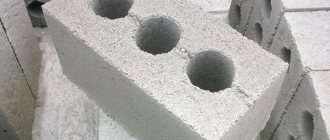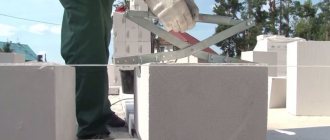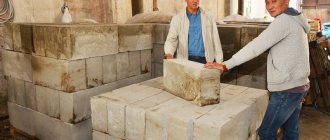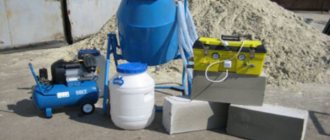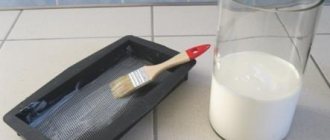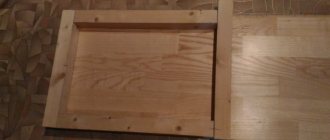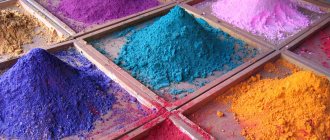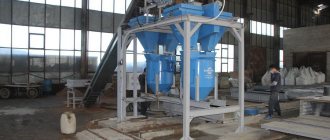Colored concrete is a material that is obtained by adding various dyes and additives to ordinary cement mortar. Painting can be carried out in two ways - by painting a ready-made concrete structure or part, or by adding a substance to the solution. In this way, it is possible to obtain concrete that is saturated and bright in a variety of shades.
Colored concrete is used in the production of bright borders, colored paving slabs, and other products. Multi-colored concrete does not change its properties and characteristics, adding a colored dye to the solution does not affect the material, and the coloring method even improves the parameters, since often the processing includes the addition of substances that ensure the material’s resistance to various influences and protect it.
All painted concrete structures remain strong, reliable, and last as long as possible. The coloring technology is quite simple and can be implemented both in a factory and directly on site with your own hands.
The main advantages and disadvantages of colored concrete
Colored concrete has certain pros and cons, which directly depend on the characteristics of the material, its composition, and appearance.
Advantages of colored concrete:
- Beautiful and original appearance, which allows you to use the material to implement a wide variety of ideas and plans
- Possibility to choose the exact color and shade for finishing the facade or territory
- Preservation of pigments of original saturation and brightness for a long time
- Ease of preparation and coloring of the solution - different methods of coloring are relevant for certain tasks and conditions, but both can be done with your own hands
Among the disadvantages, it is worth mentioning that to create a durable and rich, wear-resistant coloring, it is necessary to use special pigments for concrete, which cannot be cheap, white cement and sand. As a result, colored concrete costs much more than usual (on the other hand, it allows you to save on other finishing materials if used in decoration).
An important feature is strict adherence to technology when implementing both dyeing methods: the preparation instructions indicate the required amount of dye, the exact proportions and composition of the mixture. And it’s better not to violate anything, since saving on some materials can lead to a fiasco - a deterioration in the strength characteristics of concrete or a discrepancy between the chosen shade.
Average costs for colored concrete
Dry pigments and dyes for concrete are available at prices starting from RUR 95/kg . Considering that a 50 kg bag of Portland cement will require about 3 kg, the costs are significant. Approximately the same costs should be expected for liquid pigments for concrete.
Acid dyes are available at a price - from 350 rubles / l , taking into account the consumption, the method also cannot be called the cheapest, unlike water-based acrylic paints, the cost of which starts from 155 rubles / l. Financial costs for molar work vary from 60 to 450 rubles per square meter.
Where is it used?
The scope of application of colored concrete is quite extensive. Usually the material serves a decorative function, since the color does not affect the characteristics in any way and only changes the appearance of the surface.
The following are made from colored concrete: paving stones, driveway and garden paths, tiles for sidewalks and borders, open terraces, landscape and facade decor (columns, flowerpots, whitewash, fountains, figurines, etc.), small bridges over artificial ponds, playgrounds for small size, elements of fences and fences.
Walls and floors are made from such concrete less frequently, but mainly in individual construction. In industrial construction, colored concrete is used less frequently due to its high cost. In road construction, concrete, the color of which differs from the shade of other structures, is used to highlight strips, small areas, and zones.
Combination with other finishing materials
- With a tree. Combining with wood will make the interior warmer, it will soften the cold material. A similar solution is suitable for a room in country, loft, or eco-style.
- Brick. Brick and concrete look harmonious together. An ideal combination for a loft interior. Depending on the color of the brick, the room will be cold or warm.
- Glass. The combination creates a strict and brutal interior. Glass can serve as a partition, protection or decorative addition. Glass on top of a concrete wall will provide a reflective surface, which will visually increase the area and look interesting in the overall picture.
- Metal. Metal and chrome surfaces will continue the stylistic idea. An ideal combination for hi-tech and loft style.
Options for adding color to concrete products
To understand how to make colored concrete with your own hands, you need to study the features of both methods and choose the one that best suits your goals, functions, operating conditions and capabilities.
Preparation of a colored solution
The color of concrete is provided by special pigments; the material can be made at the mixing stage. It is important to maintain the correct proportions and select the correct composition. When a concrete dye is introduced directly into the composition, the color does not wear off over time and remains saturated over the entire surface. This method is relevant in the manufacture of paving slabs and other elements whose surface will be subject to stable loads.
How to make colored concrete with your own hands:
- Take 2.5 parts white sand, ¼ part water, 4 parts fine-grained gravel, 1 part white cement, 5% of the total volume of a special dye of the desired color.
- All dry ingredients must be thoroughly mixed, poured with water, mixed again until a homogeneous consistency is obtained and used. This solution is suitable for creating a surface with a medium degree of wear resistance.
- If the load is increased, you need to reduce some of the gravel and sand. Strength can also be increased by introducing special water-repellent additives, plasticizers, additives to accelerate the hardening of the solution, and dust-removing compounds.
Coloring
The color of concrete can also be changed thanks to special impregnations - they are used to paint ready-made structures. The composition is made on the basis of a polymer with pigment and active substances, thanks to which the shade is not washed out of the monolith for a long time. Most often, surface dyes are used to treat concrete and cement-sand screeds.
Main properties of impregnation:
- Giving the concrete surface the desired shade
- Protection against abrasion, wear, noticeable strengthening of the top layer of material
- Moisture protection
External finishing with dyes ensures penetration of the substance into the stone to a depth of 1-2 centimeters. All pores are filled, protection and strengthening are carried out, and the structure of the concrete is preserved. This is how floors are treated after leveling and the surfaces of floors are covered before laying linoleum.
There is also a colored sealer for concrete surfaces. Supplied in a dry mix format with a cement binder and dye in the composition. The product is applied to the newly laid concrete in 2 layers, and then rubbed in. The color is very intense, and after the concrete has set, the result lasts for a long time even with active abrasion.
Method 2: Deep Approach
For the manufacture of piece cladding and decorative elements, painting the surface is not suitable - the process will become very labor-intensive. For the manufacture of sidewalk tributaries, borders, and garden products, coloring with colored pigments for concrete is used throughout the entire volume. Products will have color immediately after production (mold filling and hardening).
Colored cement and concrete mortar is also used for pouring colored floors with complex patterns.
General principle of preparing the solution
There is nothing complicated in the process of preparing the solution. To mix, take cement of the desired brand, sand and water in standard proportions. The pigment is introduced into the dry binder and mixed thoroughly with it to evenly distribute the color. Its amount should not exceed 5% of the total mass.
Colored additives for concrete
There are several types of pigments for coloring the solution.
- Acid dyes. These are pigmented powders that are harmless to humans. By reacting with water, the particles are activated and deeply absorbed into the structure of the components, giving the future stone its color.
- Acrylic powders give concrete a rich color. Its intensity depends on the amount of pigment introduced into the solution.
- Metal connections. Example in the table:
| Color | Additive |
| White | Titanium dioxide |
| Yellow | Iron oxide |
| Red | Iron oxide concentration |
| Black | Iron oxide + carbon black |
| Green | Chromium oxide |
| Brown | Umber and iron oxide |
The main requirement for dyes is the absence of heavy metals in their composition.
In general, there are additives of organic and inorganic origin, synthetic and natural. Pigments of the same origin can be mixed to obtain individual shades according to color mixing rules.
Manufacturing technology
The rules and features of making colored concrete depend on how much dye is used and what result needs to be achieved. Pigments can also be different, with certain properties and mixing technology.
Universal recipe
To give color to concrete with your own hands, you need to properly prepare the solution. As stated above, a lot depends on the pigment, the instructions for which you must read all the information. It is important to maintain the mixing proportions.
Ingredients for preparing a universal solution:
- Fine gravel - 4 parts
- Pure white sand – 2.5 parts
- Water – 0.25 parts
- Cement grade M150-M300 (depending on the functions and operating conditions of the structure) – 1 part
- Pigments - in the amount specified in the manufacturer's instructions
This solution is suitable for floor coverings and paving slabs, as it resists wear and tear and does not fade. Over time, the color of concrete may become distorted due to objective factors (surface contamination, for example), but not due to the pigment losing its brightness. If you follow the instructions and technology, colored concrete will turn out to be the desired shade, which will last for years.
To create colored coatings in a parking lot, garage and other places with increased requirements for wear resistance, the proportions of sand and gravel are changed to 2.5 and 1.5, respectively. To create decorative surfaces, it is allowed to add scrap mineral stones: granite, mica, onyx and others.
How to ensure high surface quality
Before making colored concrete at home using the method of preparing colored concrete, it is advisable to make sure that the materials chosen for preparing the solution meet the required standards. To avoid efflorescence, it is important that the gravel is perfectly clean, the water is soft (without or low mineral content), and the cement is completely dry and clean.
The finished concrete is poured into molds, cared for properly, and water is sprayed over the surface during the first 3-5 days. If efflorescence does appear, treatment with acid and other untested solutions is excluded. This phenomenon can be avoided by using silicone impregnations.
Conclusion
To make a choice of coloring composition, you should rely on the capabilities and need for color intensity. For dense coverage of an existing surface, only impregnations and fixatives are suitable. A small layer of colored mortar can be poured onto the existing screed.
When making new elements, it is advisable to paint the concrete over the entire volume in order to avoid unnecessary work on covering the products. Moreover, purchasing pigments is less expensive than purchasing a separate impregnation, and the technology for preparing the composition does not differ from the standard one.
- Exterior finishing
Recommendations for the use of dyes
- You should avoid introducing more additives than indicated in the instructions in order to improve the color of the solution - if you overdo it, the concrete will be of lower quality and will begin to delaminate. All proportions must be strictly observed.
- Pigments should be added to the mixture in small portions, mixing carefully and thoroughly until a consistency is uniform in structure and color.
- If there is a need to save coloring matter, you can first fill the area with ordinary solution two-thirds, then cover the remaining part with colored concrete. The layers must be poured without interruption so that the monolith is firmly set and the coloring quality is high.
- The requirements for materials are important and require attention - for example, if you use gray cement instead of white (as indicated) to prepare colored concrete, you will not be able to achieve the desired shade - the color will be darker and duller.
- The amount of dye should not exceed 10% of the volume of Portland cement. The best coloring results are obtained with finely ground pigments equal to 1/100 of the diameter of the Portland cement grain.
How to make dyes with your own hands
This video explains this issue in detail:
Or you can use the following recipe:
You can prepare the pigment for colored concrete yourself. For this you will need: lime, water, soap, lime dye and calcium chloride.
Preparation of pigment:
- Slaked lime is diluted in 5 liters of water, and the mixture is set aside.
- Dilute lime dye with water to obtain a liter of mixture. Calcium chloride is added to the coloring mixture.
- Grind the soap and dilute it with warm water.
- The coloring composition is diluted with soapy water, and the mixture is filtered until smooth.
- The concrete surface is degreased with a solvent and a coloring composition is applied.
You need to work in personal protective equipment - gloves and safety glasses are required. By mixing different pigments you can achieve the desired shade of colored concrete. In this case, all the basic rules apply: yellow and blue give green, for a darker tone add black paint, for a lighter tone add white.
Painting concrete products when making garden decor
Concrete products are painted in a variety of colors for decoration purposes. Thus, paths, borders, and original elements made of colored concrete look good in garden areas. They can be single-color, multi-colored, two- or three-color. The implementation of the work can be considered using the example of making a multi-colored path for the garden.
How to create a path in the garden from colored concrete:
- Mark the territory - drive in pegs and stretch ropes between them.
- Remove the top layer of soil, remove plant debris and debris.
- Line the trench with a layer of roofing material (to protect the concrete from moisture) so that the edges of the insulating material extend beyond the trenches.
- Make formwork from boards or moisture-resistant plywood (if you plan to pour colored concrete, but when the finished products are laid, it is not needed).
- Prepare a solution of colored concrete, pour in small portions with parallel leveling. The formwork can be removed after 2-3 days, the path will be ready for use after 7 days.
- If the path is created from ready-made stone, instead of pouring, all the elements must be placed in the trench in the required order on a sand bed 15 centimeters thick. During the installation process, the evenness is checked using a building level.
Painting products - stage of making garden decor
Creating an original garden decor from colored concrete can be done in three ways: preparing a colored solution and then pouring it, painting the surface and combining these two methods to obtain a more intense and clear result.
Coloring concrete by adding pigment to a dry cement mixture is usually done using mineral dyes based on salts and oxides of various metals. For decorative stone paths and paving slabs, choose inexpensive iron oxide pigments (Fe3O4, Fe2O3 and others) in black, red, brown, yellow. Organic aniline dyes are also used, but they are afraid of the alkali of concrete and ultraviolet radiation.
The dosage of iron oxide pigments should not exceed 5% of the total volume, but better than 2-3% of the total weight of the concrete (the shade will be pale, but the concrete will retain high strength). To prepare it at home, it is recommended to dilute the pigment in equal proportions with a deep penetration primer and let it sit for 2 hours. A mixture of pigment and substance will give a more uniform shade. If soot is used as a pigment, it must be diluted with a primer.
When colored concrete is created with uneven coloring (imitation of different textures, structures), then several concrete solutions are prepared, then they are mixed not very intensively, achieving the desired concentration, original stains, patterns. When preparing colored concrete for pouring into molds, dyes are often applied to the surface of the mold itself, which gives original effects.
It must be remembered that iron oxide pigments can absorb solution water to varying degrees, which is taken into account when determining proportions.
Coloring ready-made elements:
- Makes the surface smooth, the desired color, and protects.
- The pigment is added to the ready-made impregnation, which ensures that the substance penetrates a couple of millimeters into the concrete.
- Penetrating water repellents, colorless primers, and varnishes are chosen as impregnations. They are mixed and applied very simply, you can do everything yourself according to the instructions.
- First, prepare: dissolve the mixture in impregnation (based on water, acetone, white spirit, drying oil, etc.), prime the surface if necessary (if a primer or mixtures incompatible with the substance are used as a base, then the priming step can be skipped) .
- Apply impregnation in several layers with a brush, roller or spray.
Surface preparation
Protect all nearby surfaces and the surrounding area from splashes, contamination, and contact with equipment. The work site must be closed. The work area can be roughly divided into sections, using walls, columns, seams and other structures as reference points.
For best results, LITSIL® D40 should be applied after the surface has been repaired with LITSIL® S70 and sanded with 200 grit diamond tools. If polishing is not provided, it is necessary to apply paint at a sanding level of at least 100 grit.
Wet concrete must be dried to the point where the surface pores are free of water. At low temperatures or high humidity, concrete drying must be increased to achieve the moisture level necessary for maximum penetration of the composition.


